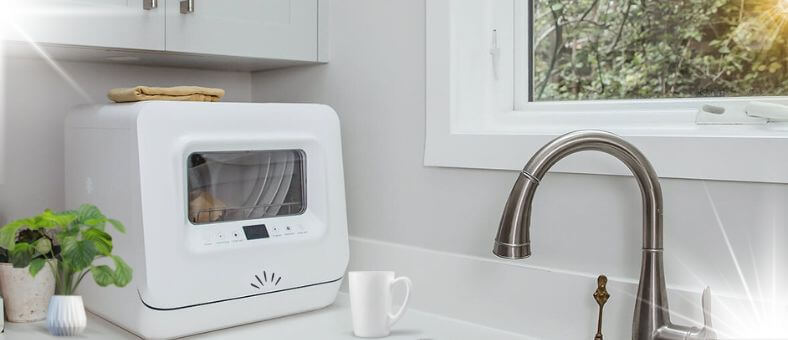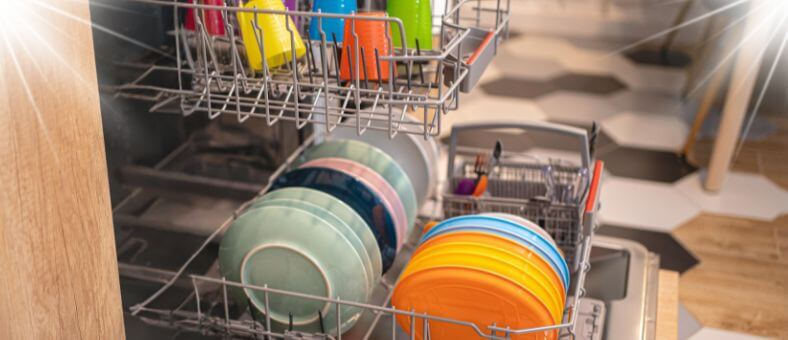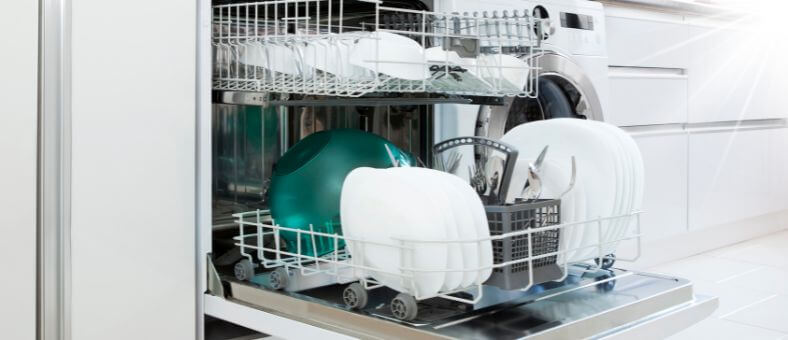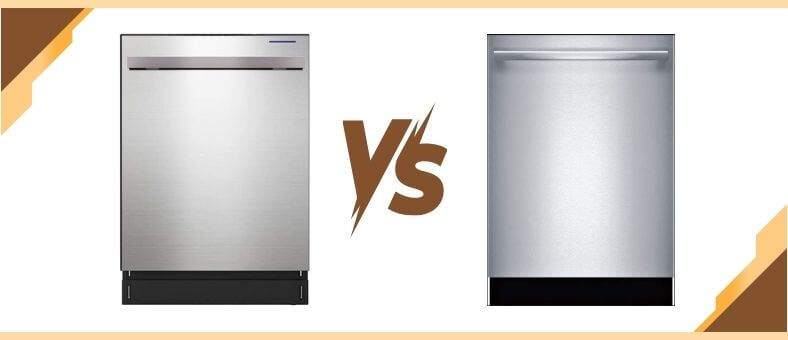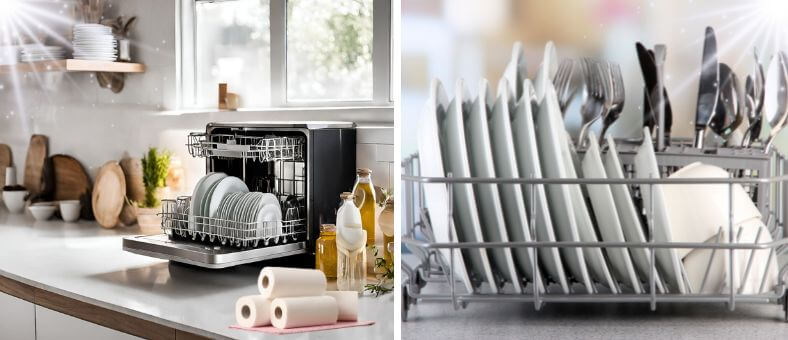Have you ever stood in front of your kitchen, marveling at the compact appliance on your countertop, and pondered, “How do countertop dishwashers work?” Well, you’re not alone. That petite powerhouse has fascinated many with its efficiency and size. The wonders of modern technology have condensed the dishwashing process, traditionally requiring a considerable chunk of space, into a device that snugly fits on your counter.
Dishwashers, especially the countertop varieties, have become synonymous with convenience in our bustling lives. But what lies beneath their shiny exteriors? What intricate dance of machinery and technology ensures that your dishes come out sparkling clean every single time? From the silent guardian known as the float switch to the radiant warmth of the heating element, a symphony of operations is happening right under your nose.
So, whether you’re a curious homeowner, an apartment dweller limited on space, or someone just itching to decode everyday gadgets, this guide will unravel the magic behind these compact wonders. And if you’re looking to explore beyond just the countertop versions, check out our guide on Types of Dishwashers. Dive in with us; you’ll understand their inner workings by the end and might appreciate every cleaned dish more.
Compact Efficiency
Countertop dishwashers don’t just sparkle up your dishes; they’re eco-warriors in disguise. They are conservation champions because they can save up to 40% water compared to traditional hand washing. That’s a win for our planet and a gentle nod to our monthly bills. Opting for a countertop dishwasher is like giving Mother Earth a little high-five while being kind to your wallet!
Table of Contents
#1 Securing the Clean: Door Latch
Let’s focus on a component you may not usually notice but plays a crucial role: the door latch. At a glance, it’s a simple mechanism. However, its importance can’t be overstated. By securing the door, this latch ensures that the cleaning process is both safe and efficient. When the door is locked, no water or soap escapes, giving your dishes the optimal environment for a thorough clean. Beyond cleanliness, it’s also a matter of safety. A well-functioning latch ensures that hot water and steam stay inside, protecting you from unintended accidents. So, that reassuring ‘click’ sound isn’t just about locking the door; it’s about ensuring the best and safest washing cycle.
#2 The Brain Behind Operations: Control Board
It might sound high-tech, and well, that’s because it is! The control board is the unsung maestro directing each part of the washing symphony. When you select a specific cycle or setting, this component communicates your command to the rest of the machine. It’s responsible for determining how much water to use, the duration of the wash, and even when to heat things up or cool them down. Like an orchestra conductor, it ensures every other component works harmoniously, delivering spotlessly clean dishes every time.
#3 Ensuring Water Flow: Water Valve
This component is the reliable gatekeeper that regulates water’s entry into your dishwasher. Think of it as a diligent traffic officer, controlling the inflow and making sure it’s just right for the wash ahead. Too much or too little water can hinder the cleaning process, but the perfect balance is struck every cycle with the water valve on the job. Ensuring that your dishes get the right amount of water for a thorough cleanse without any wastage is paramount. It’s the art of precision, ensuring every wash is as efficient as possible.
#4 Safeguarding Against Overflows: Float Switch
Have you ever wondered how your dishwasher knows when it’s full and prevents that mini tsunami in your kitchen? Or why sometimes, seemingly unrelated, the sink might fill up when running the dishwasher? All thanks to this nifty little gadget. Its main duty? To monitor the water level inside the machine and ensure it doesn’t exceed what’s needed. The float switch springs into action if the water gets too high, signaling the dishwasher to stop filling. It’s like having a diligent lifeguard on duty, ensuring everything remains safe. Thanks to the float switch, overflows are a thing of the past!
#5 Powering the Cleanse: Wash Motor
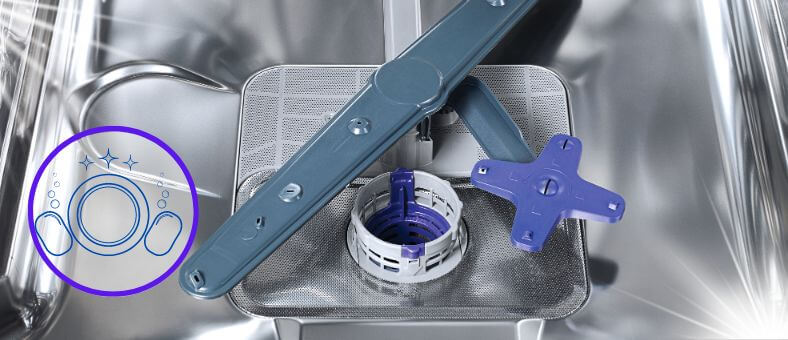
Onto the heart of the cleaning process: the wash motor. This dynamic component sets the water in motion, spraying and swishing it around to give your dishes an impeccable cleanse. The wash motor ensures the water reaches every nook and cranny, scrubbing away food particles and stubborn stains. And while it’s doing its job so effectively, you might sometimes wonder about keeping the dishwasher itself in prime condition. For that, check out The Easiest Way to Clean a Dishwasher.
Acting as the muscle behind each cycle. It’s the workhorse of your dishwasher, tirelessly churning water around to ensure every plate, fork, and glass emerges spotless. When you hear that familiar hum from your dishwasher, know that it’s the wash motor giving it all to serve you pristine dishes.
#6 Generating the Right Heat: Heating Element
Now, the part that adds warmth to the mix is the heating element. Beyond cleaning, dishwashers need to sanitize, and that’s where our trusty heating element steps in. This component heats up the water to the ideal temperature, ensuring not just cleanliness but also the elimination of germs and bacteria. Interested in how sanitization in dishwashers works? Take a look at The Sanitization Function in Dishwashers.
It’s like the sun of the dishwasher world, providing the perfect amount of warmth for optimum cleaning. Plus, post-wash plays a vital role in drying your dishes, ensuring they’re ready to be used straight out of the machine. A true multitasker, the heating element keeps things hot and dry, just as we like it!
#7 Wrapping Up the Cycle: Drain Pump
And finally, as we approach the end of the cycle, let’s spotlight the unsung hero that ensures a tidy finish: the drain pump. After all the washing and rinsing, this gadget leaps into action, efficiently draining away the used water. It’s like the final curtain call after a spectacular show, ensuring everything wraps up smoothly and cleanly. Thanks to the drain pump, your dishwasher is left devoid of murky water, prepped and ready for the next batch of dishes that await its cleansing embrace.
Countertop Dishwasher Installation: A Simple Guide
Got your hands on a shiny new countertop dishwasher? Exciting times! Now, let’s walk through the straightforward process of making it an integral part of your kitchen.
Start by finding an ideal spot near your kitchen sink. It’s essential as your dishwasher requires direct access to water. Positioning it by the sink not only ensures easy access to water but also facilitates the drainage process.
Most countertop dishwashers have a hose designed to connect directly to your faucet. Once you’ve chosen your spot, screw on the provided faucet adapter. This nifty gadget bridges your dishwasher and faucet, guaranteeing a consistent water flow.
Next up, the power! Plug your dishwasher into a nearby electrical outlet. It’s crucial to ensure the outlet matches the appliance’s power needs. A quick caution: to maintain safety, it’s best to avoid extension cords.
Lastly, remember the drain hose. It typically rests within the sink and manages the wastewater. Position it correctly to ward off any unexpected spills.
It’s as simple as setting up a new coffee machine – position, connect, plugin, and you’re all set to enjoy spotless dishes! However, remember each dishwasher model is unique. So, peering at the user manual for model-specific guidelines is always wise.
Silent Workers
Some countertop dishwashers operate below 50 decibels. That’s quieter than your average conversation! Clean dishes without the noise fuss.
Pros & Cons At A Glance
Pros:
- Countertop dishwashers are compact and easy to store, making them excellent choices for small kitchens or apartments where space is at a premium.
- They use less water per wash than standard dishwashers, offering an eco-friendly and cost-effective solution.
- Being portable, they can be effortlessly relocated, particularly useful for renters or those who move frequently.
- Without the need for complex installations, they are user-friendly, requiring just a faucet connection via an adapter.
- They are generally more affordable than their full-sized counterparts, making them a cost-effective solution for those on a budget.
Cons:
- Due to their size, they have a limited capacity. They might not cater to the needs of larger families or gatherings.
- Compatibility issues can arise as not all faucets might seamlessly connect with the provided adapters.
- While they serve the primary function of cleaning dishes, they may not offer the variety of advanced features or washing modes found in larger models.
- Their compact size might mean compromising on certain washing features like powerful jets or specialized zones for heavily soiled dishes.
Countertop vs. Portable: What’s the Difference?
If you’re stepping into the world of dishwashers, you might have heard of countertops and portable variants. While both serve a similar primary function – you guessed it, washing those pesky dirty dishes – how they fit into your home and lifestyle differs significantly. Let’s break it down.
Countertop Dishwashers
- These are compact buddies designed to sit right on your countertop. They’re about the size of a microwave oven, so you won’t have to reconfigure your kitchen to accommodate one.
- You generally just connect them to a nearby faucet, plug them in, and you’re all set. No special plumbing is needed.
- They might be better for smaller households. But for singles, couples, or small families. Perfect match!
- Once they’re set up, they generally stay put. So, while they only occupy a little space, they claim a spot on your countertop.
Portable Dishwashers
- They’re a tad larger, resembling a tall kitchen cart. Some even come with a butcher block top!
- They usually connect to a faucet when needed and can be rolled away after.
- Offering more space means you can handle a more significant stack of dirty dishes. Think dinner parties or family gatherings.
- With wheels on the base, you can roll them around. They’re like the free spirits of the dishwasher world.
Who Can Use a Countertop Dishwasher?
Countertop dishwashers are a dream for those living in compact spaces like studio apartments or cozy condos. They’re perfect for single professionals, college students in dorms, or even newlyweds just starting out. Additionally, if you’re someone who’s constantly on the move or maybe living in a rental, the portability and non-permanence of these dishwashers can be a major plus.
However, if you’re part of a bustling family of four or more or frequently host dinner parties, this compact wonder might need to catch up with your dish loads. While countertop dishwashers cater brilliantly to specific lifestyles, it’s vital to assess your daily needs to determine their fit.
Quality & Efficiency: Are They Good?
Regarding quality, most countertop dishwashers are designed with durability in mind. While they might not have the vast array of features that some high-end, full-sized models boast, they’re built to perform their primary job – cleaning dishes – and they do it well. Their interiors, often made of stainless steel, are designed to withstand the test of time and regular use.
Efficiency-wise, these dishwashers can be quite impressive. They use less water per cycle than their larger counterparts, making them eco-friendlier. With technological advancements, many models now come with energy-saving modes that reduce consumption and costs.
However, a key point to remember is that, like all appliances, not all countertop dishwashers are created equal. It’s advisable to research specific brands, read reviews, and maybe even test a few out, if possible, before making a purchase. When chosen wisely, a countertop dishwasher can offer an effective, eco-friendly, and economical solution for many households.
Can You Place a Countertop Dishwasher Beneath the Sink?
While countertop dishwashers are primarily designed to sit on countertops, some creative homeowners have managed to slide them under their sinks. This works well for those keen on saving even more space or maintaining a particular aesthetic in their kitchen.
However, several factors come into play. The size and depth of your under-sink cabinet matter. You’ll need to ensure there’s ample space not only for the dishwasher but also for its hoses and connectors. Accessibility is another key consideration. Since you’ll need to load and unload dishes, you would want to avoid a setup where it becomes a daily struggle.
Furthermore, ventilation is crucial. Like all dishwashers, countertop versions emit steam, which can damage wooden cabinets over time. If you’re considering this setup, it’s advisable to consult with a professional or someone experienced in home DIY projects to ensure safe and practical fitment.
A quick tip
Always give the user manual a thorough read. Each model might have little quirks, and being informed will make the process smoother.
Types of Countertop Dishwasher
While ‘countertop’ generally gives a singular image, you’d be surprised at the variety within this category. Here’s a glimpse into the diverse world of countertop dishwashers:
Traditional Countertop Dishwashers
The most common type, these are designed to fit most standard-sized countertops and connect directly to kitchen faucets. They’re compact, portable, and offer a range of washing cycles.
Specialty or Premium Models
As the name suggests, these dishwashers might come with advanced features or specialized washing modes. They can have LED displays, stainless steel interiors, or even specialized jets for intense cleaning.
Manual Fill Dishwashers
For places where a direct faucet connection isn’t possible, these dishwashers allow you to manually fill them up. They’re versatile and often favored by those living in unconventional spaces.
Drawer-Style Countertop Dishwashers
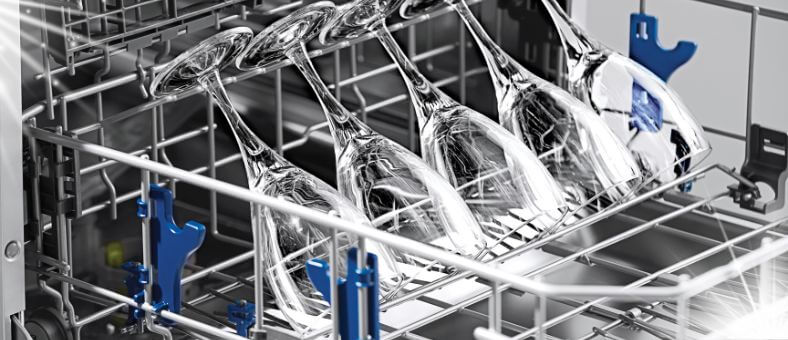
These are a hybrid between traditional countertops and drawer dishwashers. They offer the compactness of countertop versions but pull out like a drawer, making loading and unloading a breeze.
Wrapping Up: How Do Countertop Dishwashers Work
Navigating the intricate workings of countertop dishwashers might have initially seemed like a daunting journey, but together, we’ve broken it down into digestible bits. By now, you’ve garnered a deeper understanding of the mechanics and versatility of these compact kitchen marvels. Undeniably, they are convenient and efficient, especially for those with space constraints or smaller households.
If you’ve been on the fence, consider this: Life’s too short to be bogged down by mundane chores. Embrace the modern conveniences at your fingertips. Dive in, make the investment, and let your countertop dishwasher take the hassle out of clean-ups. Here’s to simpler, shinier days ahead!
At WashDryDazzle, we’re dedicated to providing essential insights that make your daily chores effortless. Dive deeper into our comprehensive Dishwasher Education hub to learn more.
Frequently Asked Questions (FAQs)
Which brands are considered the best for countertop dishwashers?
Some top brands for countertop dishwashers include SPT, Danby, EdgeStar, and Farberware, based on user reviews and expert recommendations.
What type of detergent should I use for my countertop dishwasher?
For most countertop dishwashers, it’s recommended to use a detergent formulated explicitly for automatic dishwashers. This ensures effective cleaning without producing too many suds, which can affect the machine’s performance.
Can I use regular dish soap instead of dishwasher detergent in my countertop dishwasher?
It’s best to avoid using regular dish soap in countertop dishwashers. Regular dish soap can produce excessive suds and bubbles, overflowing and potentially damaging the appliance. Stick with products labeled for use in automatic dishwashers.
How much dishwasher detergent should I use in my countertop dishwasher?
Always refer to your dishwasher’s manual for specific guidelines. However, countertop dishwashers typically require less detergent than their full-sized counterparts. Using too much can result in residue on dishes or harm the dishwasher.
Are there eco-friendly dishwasher detergent options suitable for countertop dishwashers?
Absolutely! Several eco-friendly dishwasher detergent brands are available that work effectively in countertop dishwashers. They’re designed to be biodegradable and free from harmful chemicals, providing an environmentally conscious cleaning option. Always check the product’s label to ensure it’s safe for use in automatic dishwashers.
How does hard water affect the performance of countertop dishwashers?
Hard water contains minerals like calcium and magnesium. Over time, these minerals can accumulate inside the dishwasher, leading to scale build-up. This affects the machine’s efficiency and leaves dishes and glassware with spots or filmy residues.

